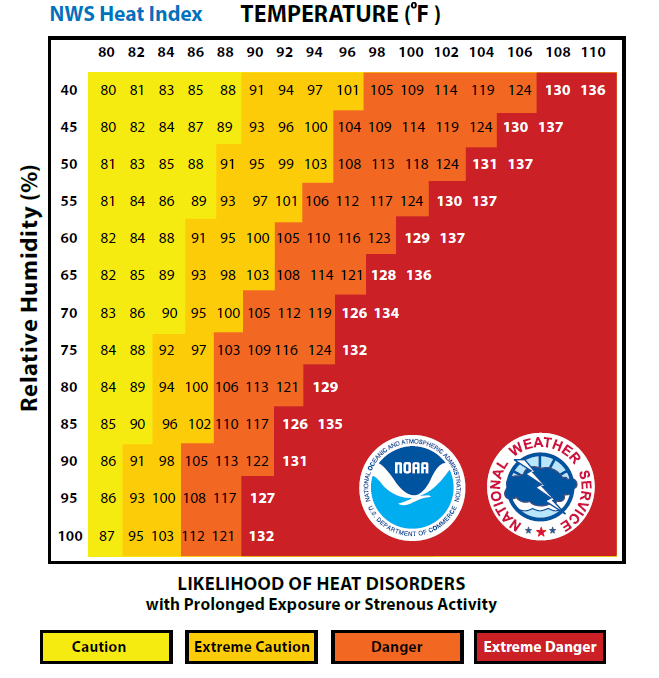Lots of heat on the way for Indiana
The “dog days” of summer are here! The National Weather Service is predicting a significant heat wave for much of the Midwest beginning about July 15 and extending several days. Heat indexes of 100o or higher are expected, which will be the hottest stretch of weather so far this season. Extremely hot weather can cause health-related challenges for people and animals alike, and Indiana’s humidity tends to increase the effects of the already hot temperatures. Although we usually can’t just stop our activities and stay in the air conditioning during a heat wave, being aware of conditions and taking steps to prevent heat-related illnesses can make the hot stretch much more bearable.

What is the heat index?
The heat index is a way to measure how hot it actually feels when humidity is considered with the temperature. As the humidity level rises, the body’s ability to cool itself is reduced because sweat does not evaporate as readily, therefore it feels hotter than the “actual” temperature. For example, when the temperature is 95o and the relative humidity is 50%, the heat index is 105o. During times of high heat indexes, air quality may also be adversely affected which can cause breathing difficulties for individuals with health conditions.

Heat Related Illnesses:
HEAT CRAMPS: Muscular pains and spasms due to heavy exertion. Although heat cramps are the least severe, they are often the first signal that the body is having trouble with the heat.
Treatment – Move to a cooler, shaded location, drink fluids. Monitor for signs of heat exhaustion or heat stroke.
HEAT EXHAUSTION: Typically occurs when people exercise heavily or work in a hot, humid place where body fluids are lost through heavy sweating. Blood flow to the skin increases, causing blood flow to decrease to the vital organs. This results in a form of mild shock. Symptoms include feeling faint or dizzy; excessive sweating; cool, pale, clammy skin; nausea; and rapid, weak pulse. If not treated, the victim’s condition will worsen. Body temperature will keep rising and the victim may suffer heat stroke.
Treatment – Get to a cooler, air conditioned place if possible. Have the victim drink water if they are fully conscious. Lower body temperature by a cool shower or cold compresses. Monitor for signs of heat stroke.
HEAT STROKE (or SUN STROKE): A life-threatening condition!!! The victim’s temperature control system, which produces sweating to cool the body, stops working. The body temperature can rise so high (above 103o) that brain damage and death may result if the body is not cooled quickly. Heat stroke symptoms include a lack of sweating, with red, hot, dry skin; confusion and/or a throbbing headache; nausea; a rapid but strong pulse; and a possible loss of consciousness.
Treatment – Request emergency assistance: call 9-1-1 immediately! Move the person to a cooler place and cool the victim using wet cloths or a cool bath while waiting for EMS. Do not give the victim anything to drink.
Reducing the risk of heat-related illness:
Dress appropriately – wear lightweight, loose-fitting, light-colored clothing that will reflect heat away from the body.
Slow down! – reduce, eliminate, or reschedule strenuous activities until the cooler times of the day such as very early in the morning, or the evening hours. Employers should ensure that staff have access to plenty of water, shade, and rest breaks to prevent heat illnesses.
Drink plenty of water – drink water even if you don’t feel thirsty. Avoid or moderate consumption of alcoholic or caffeinated drinks, as they will cause dehydration.
Minimize direct sun exposure – sunburn will reduce your body’s ability to dissipate heat. If you must work outside, try to spend time in a shaded, breezy area.
Use air conditioners! – if your home is not air-conditioned, consider visiting air-conditioned locations such as stores, libraries, or friends and family during excessive heat conditions.
Use portable electric fans – fans exhaust hot air from a room or draw in cooler air. However, if the room temperature is above 90o, do not direct the fan’s flow directly toward yourself, as the blowing air will dehydrate you faster.
Watch out for the most vulnerable – senior citizens, infants and children, and those with chronic health conditions are more susceptible to heat-related illnesses. Check on your family, friends, and neighbors during a heat wave and assist them if needed. And never leave children, disabled adults, or pets in a car!
Remember your pets and livestock – pets and livestock should be provided access to plenty of fresh, cool, clean water and a source of shade, preferably with a breeze. Keep ventilation systems in livestock buildings in working order, and provide supplemental cooling such as misters or additional fans as needed.
For more information about extreme heat, please visit the following sites:
INPREPared’s Extreme Heat Resource Page
National Weather Service “Heat Safety” Fact Sheet
National Weather and Resources Service Heat Safety Tips
